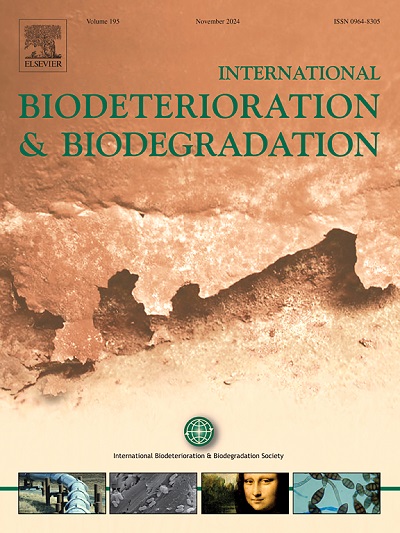Characterization of biopolymers isolated from a pilot-scale membrane bioreactor treating municipal wastewater
IF 4.1
2区 环境科学与生态学
Q2 BIOTECHNOLOGY & APPLIED MICROBIOLOGY
International Biodeterioration & Biodegradation
Pub Date : 2025-02-01
DOI:10.1016/j.ibiod.2025.106010
引用次数: 0
Abstract
Biopolymers have been widely recognized as playing an important role in membrane fouling in membrane bioreactors (MBRs). In-depth characterization of biopolymers in MBRs can provide important insights into membrane fouling. In this study, ultrafiltration was used to selectively isolate biopolymers (recovery rate: 70%) from a pilot-scale MBR treating municipal wastewater. The characteristics of the isolated biopolymers were compared against those of model substances, such as sodium alginate (SA) and bovine serum albumin (BSA), which have been used in many previous studies. Lipopolysaccharides (LPS), which have been proposed as alternative model polysaccharides for MBR fouling research, were also characterized. Batch filtration tests demonstrated that the isolated biopolymers had a considerably higher fouling potential than the model substances. A modified liquid chromatography with organic carbon detection (LC–OCD) analysis showed that the constituents of the isolated biopolymers had molecular weights of >1,000,000 Da. Such macromolecular constituents were only detected in LPS among the model substances. A Fourier-transform infrared (FTIR) analysis indicated various constituents for the isolated biopolymers, such as polysaccharides, proteins and lipids. A quartz crystal microbalance (QCM) analysis demonstrated that the isolated biopolymers had a high affinity to polyvinylidene fluoride (PVDF), explaining the high fouling potential of these biopolymers.

中试膜生物反应器处理城市污水分离生物聚合物的特性研究
生物聚合物在膜生物反应器(mbr)的膜污染中起着重要的作用。深入表征mbr中的生物聚合物可以为膜污染提供重要的见解。在本研究中,采用超滤技术选择性地从MBR处理城市污水中分离生物聚合物(回收率为70%)。将分离得到的生物聚合物的特性与海藻酸钠(SA)和牛血清白蛋白(BSA)等模型物质进行了比较。脂多糖(LPS)已被提出作为MBR污染研究的替代模型多糖,并对其进行了表征。批量过滤试验表明,分离的生物聚合物具有比模型物质高得多的污染潜力。改良液相色谱-有机碳检测(LC-OCD)分析表明,分离得到的生物聚合物的组分分子量为1,000,000 Da。这些大分子成分在模型物质中仅在LPS中检测到。傅里叶红外(FTIR)分析表明,分离的生物聚合物含有多种成分,如多糖、蛋白质和脂质。石英晶体微天平(QCM)分析表明,分离的生物聚合物对聚偏氟乙烯(PVDF)具有高亲和力,解释了这些生物聚合物的高污染潜力。
本文章由计算机程序翻译,如有差异,请以英文原文为准。
求助全文
约1分钟内获得全文
求助全文
来源期刊
CiteScore
9.60
自引率
10.40%
发文量
107
审稿时长
21 days
期刊介绍:
International Biodeterioration and Biodegradation publishes original research papers and reviews on the biological causes of deterioration or degradation.

 求助内容:
求助内容: 应助结果提醒方式:
应助结果提醒方式:


